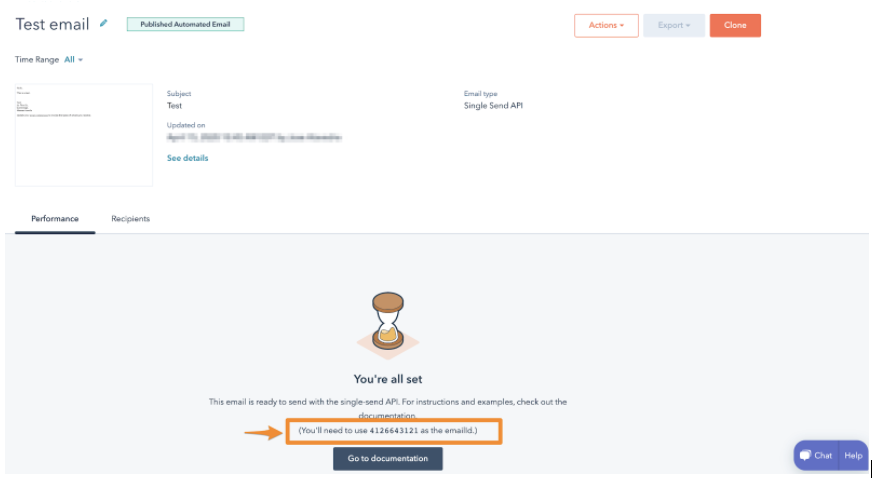Last modified: December 2, 2025
Scope requirements
Scope requirements
Requirements
To use the marketing single send API, the following requirements must be met:- You must have a Marketing Hub Enterprise account.
- The app you’re using to make API requests has been granted the
marketing-emailscope.
Create an email and send it via the single-send API
First, set up your email in HubSpot. After you create the email, you can set the recipient details, including any contact or custom properties set up in the email template, in the body of the API request. Before you can make the API request, you’ll need the ID of the email:- If you leave the email drafted without publishing it, you can get the email ID from the URL when you’re in the email editor. The ID is the final numeric value before the final slash character (
/) in the URL (e.g.,https://app.hubspot.com/email/{PORTAL_ID}/edit/{EMAIL_ID}/settings).

- If you publish your email, you can copy the email ID from the email details page.

POST request to /marketing/v4/email/single-send.
The response contains the following fields:
-
requestedAt: the timestamp of when the send was requested. -
statusId: an identifier that can be used to query the status of the send. -
status: the status of the send request. IncludesPENDING,PROCESSING,CANCELED, andCOMPLETE.
Request properties
The request body must be a JSON-formatted object with the following properties:emailIdmessagecontactPropertiescustomProperties
emailId
TheemailId field contains the email’s content ID, which can be found in HubSpot’s email tool.
message
The message field is a JSON object containing anything that you want to override. At the minimum, you must include theto field.
Message object fields:
to: the recipient of the emailfrom: the “From” header for the email. You can define a from name with the following format:"from":"Sender Name <sender@hubspot.com>"sendId: the ID of a particular send. Only one email with a givensendIdwill be sent per account, so you can include this field to prevent duplicate email sends.replyTo: a JSON list of “Reply-To” header values for the email.cc: a JSON list of email addresses to send as Cc.bcc: a JSON list of email addresses to send as Bcc.
contactProperties
ThecontactProperties field is a JSON map of contact property values. Each contact property value contains a name and value. Each property will be set on the contact record and will be visible in the template under:

last_paid_date property, as the sending of the receipt will have information about the last payment.
customProperties
ThecustomProperties field is a JSON map of key-value properties. These properties are generally related to the email itself, not the contact receiving the email. They will not appear in the web page version of the email, or in the view of the email from the contact’s timeline. These properties are also not stored in HubSpot and will only be included in the sent email.
Each key in the customProperties field can be referenced in the template using a HubL expression for fields contained within the custom variable (e.g., {{ custom.NAME_OF_PROPERTY }} ).
For example, if your email template references two properties, purchaseUrl and productName, you could provide the associated values for these properties with the following request body:
customProperties field only supports arrays when used with programmable email content. In your email template, you can reference the items defined in your customProperties field by using a HubL expression (e.g., using a for loop to render each item in a list). For example, if the customProperties you included in your request body was structured like the following JSON snippet below:
exampleArray with the following HubL code:

Query the status of an email send
To get the status of the email send, make aGET request to https://api.hubapi.com/marketing/v3/email/send-statuses/{statusId}.
The response contains the following fields:
-
sendResult: an enumeration that represents the email’s send status. The possible values are listed below. -
requestedAt: the timestamp from when the send was requested. -
startedAt: the timestamp when the send began processing. -
completedAt: the timestamp when the send completed. -
statusId: an identifier that can be used to query the status of the send. -
status: the status of the send request. IncludesPENDING,PROCESSING,CANCELED, andCOMPLETE. -
eventId: if sent, the ID and created timestamp of the sent event.
sendResult
ThesendResult is an enumeration that reflects the result of an email send attempt. Its possible values are:
SENT: the email was sent successfully.QUEUED: the email was queued and will send as the queue gets processed.PORTAL_SUSPENDED: due to Acceptable Use Policy violations, the HubSpot customer’s email has been suspended.INVALID_TO_ADDRESS: the recipient address is invalid. This error will also occur if you attempt to send an email with any of the following role-based prefixes in the email address:abuse,no-reply,noreply,root,spam,security,undisclosed-recipients,unsubscribe,inoc,postmaster, orprivacy.BLOCKED_DOMAIN: the domain cannot receive emails from HubSpot at this time.PREVIOUSLY_BOUNCED: the recipient has previously bounced, and the sending logic resulted in no send.PREVIOUS_SPAM: the recipient has previously marked similar email as spam.INVALID_FROM_ADDRESS: the From address is invalid.MISSING_CONTENT: theemailIdis invalid, or theemailIdcorresponds to an email that wasn’t set up for Single-Send.MISSING_TEMPLATE_PROPERTIES: there are properties set up in the template that have not been included in thecustomPropertiessent in the request.